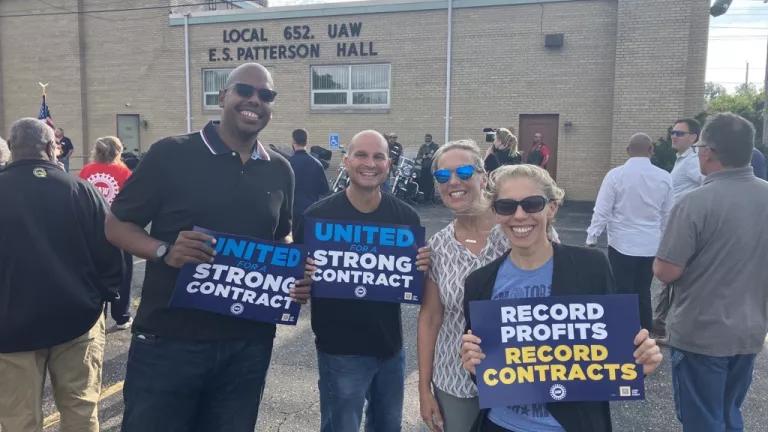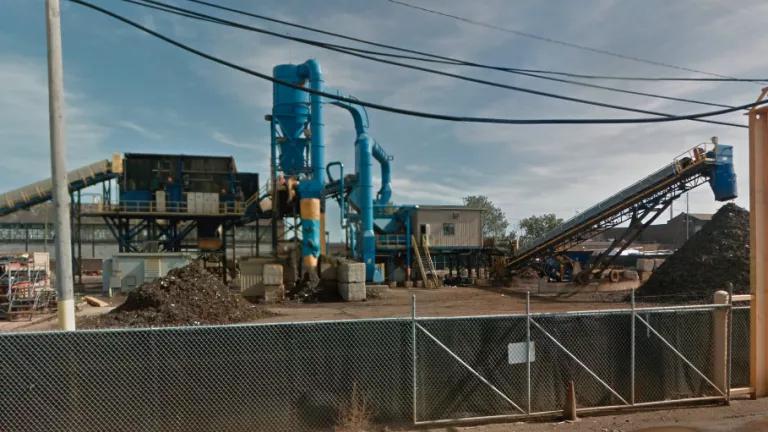Another Manganese Threat to Chicago’s Southeast Side

In the latest chapter on neurotoxic manganese threatening a Chicago residential community, recently revealed inspection reports show that the City of Chicago and EPA inspectors uncovered alarming problems with industrial dust pollution this past fall, at yet another facility handling manganese next to a densely populated residential neighborhood on the city’s Southeast Side.
The site manager for the facility (which is owned by Watco Companies, based in Kansas) told inspectors that the dust issues were part of an “isolated problem” that “will not occur again.” Only the City inspector returned the next week and found what appeared to be the same issues recurring.
NRDC and our partners are particularly concerned about the handling of manganese near communities like the Southeast Side—which is home to thousands of children and women of childbearing age—as the substance is known to threaten the nervous system when inhaled. Studies show workers exposed to elevated levels of manganese can develop Parkinson’s-like symptoms, while a growing body of research on community-level exposures shows negative impacts to children like reduced IQ, mental processing speed, and working memory. And Southeast Side advocates have been raising concerns with manganese since at least 2014, when the City adopted enhanced dust regulations to deal with black clouds of petcoke and coal dust blowing into the same community. With good reason: researchers at the University of Illinois-Chicago School of Public Health have preliminary data showing relatively high levels of manganese in the toenails of children living on the Southeast Side.
The potential health threats from manganese at the Watco facility led the Chicago Department of Public Health (“CDPH”) in late December to deny a renewed request by the company to avoid monitoring the air around its facility for pollution. The variance denial (hopefully) ends a three-year quest by the manganese-handling site to avoid installing air monitors required under the City’s 2014 dust regulations.
CDPH rejected the same request by Watco’s predecessor, Kinder Morgan, back in the spring. In both instances, the agency’s rejections came after NRDC and our community partners submitted extensive comments objecting to the requests for exemptions and detailing the health threats posed by the facility to the densely populated communities located across the street. They also came after years and years of community complaints about dust from this facility, as well as multiple inspection reports describing poor handling of materials and dust violations by Kinder Morgan (per the City’s inspection database).
Earlier this year, legal actions taken by EPA and the City compelled Pittsburgh-based S.H. Bell, another Southeast Side facility handling manganese, to install air monitors. Monitoring data from S.H. Bell subsequently showed exceedances of the federal health screening threshold for manganese, and served as the basis for a notice of violation against the company. But EPA has yet to announce any further actions against S.H. Bell, leaving community members to wonder if the agency has added this facility to its growing list of dropped balls.
After purchasing the site from Kinder Morgan as part of a 20-facility deal between these two massive companies, Watco renewed the request to avoid monitoring this summer, claiming that it is sufficiently controlling its site’s dust. The request noted Watco’s extensive use of indoor storage for dangerous materials like manganese, as well as its use of “best management practices” for controlling dust at storage and handling sites, such as adhering to speed limits for trucks, covering truck beds, and ensuring that the exteriors of trucks are clean before they leave the facility.
However, it appears that the facility isn’t in fact adhering to these best practices.
During their September tour of the facility, the agency inspectors saw extremely high levels of dust in a building used for transferring bulk materials to and from trucks. The dust was so significant that it traveled the whole length of the long building—a structure located very close to the neighboring community—and came out at both ends. According to the site manager, the dust issues were occurring because the air pollution control system on the building wasn’t operating properly. But the facility had no protocol for what to do when such an issue occurs with its pollution control system, and continued with business-as-usual when the system went down. Moreover, the site manager did not even know what material was being handled in the building at the time.

In addition to this pollution from the building, the inspectors noted a number of problems with trucks and roads at the facility, resulting in high levels of dust. Such problems included trucks traveling at more than twice the speed limit on the site, no tarping of trucks on site, and the lack of any system for washing truck exteriors and wheels to prevent them from tracking harmful substances out into the community.
The City inspector returned a week later to again find dust coming from the transfer building, as well as from trucks. So much for never again.
These inspection results confirm what residents have known all along: that these facilities cannot be trusted to consistently control their toxic dust, and are posing a public health threat to nearby communities. While installing monitors is one important step towards holding them accountable for their pollution, residents need more decisive action, and faster.
As put by Gina Ramirez, an NRDC staffer and long-time resident of the Southeast Side, in reaction to the City’s actions, “As a community member with a young child, it is still alarming that I am raising my son near such a dangerous neurotoxin when preliminary testing shows evidence of elevated levels in children. I would love to eventually have zero handling of manganese.”
She wishes the City were more proactive about pollution issues in her neighborhood, to lessen the heavy burden of constant vigilance borne by residents.
The health threats and other burdens posed by the dangerous neurotoxin manganese are one reason why NRDC and our supporting partner groups at the Southeast Environmental Task Force, Southeast Side Coalition to Ban Petcoke, Little Village Environmental Justice Organization, Moms Clean Air Force, The People's Lobby, Northwestern Pritzker Law's Environmental Advocacy Clinic, and the Chicago Legal Clinic are seeking an end not only to the pollution from these two facilities, but to the cumulative health burdens in Chicago posed by concentrated industrial sources and the trucks, trains and barges that serve them.
Our coalition is looking to EPA to bring an enforcement action against the Watco facility, as it has done in recent years against other industrial dust threats in Chicago’s Southeast Side, including the KCBX petcoke facility, Ozinga cement site, and S.H. Bell manganese-handling site. But we don’t trust that EPA Administrator Scott Pruitt and newly named EPA Region 5 Regional Administrator Cathy Stepp will do their jobs to protect this community—as noted above, EPA has taken no further public action on its notice of violation issued to S.H. Bell since August, and the agency as a whole is noticeably stepping back on holding companies accountable for pollution.
So we are calling on Mayor Emanuel to address this facility and reform industrial areas in Chicago to ensure that these communities have a brighter, healthier future, in keeping with his leadership on climate change and protecting the Great Lakes. After all, while the Great Lakes are Chicago’s greatest natural treasure, Chicago’s people are the city’s greatest treasure, period.



